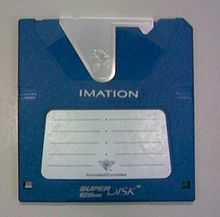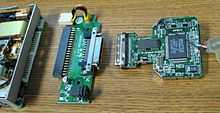SuperDisk
- Not to be confused with SuperDrive, a trademark used by Apple Computer for various disk drive products.




The SuperDisk, sometimes marketed as LS-120 and a later variant LS-240, is a high-speed, high-capacity alternative to the 90 mm (3.5 in), 1.44 MB floppy disk. The Superdisk hardware was introduced by 3M's storage products group (later known as Imation) circa 1997. Imation mainly sold Matsushita-built drives under the SuperDisk name; other companies tended to use the LS-120 name, and sold the Matsushita drives. (Matsushita was the registered name of Panasonic until 2008.) However, the system was not a huge success. Few OEMs supported it, aside from Compaq.
History
The design of the SuperDisk system came from an early 1990s project at Iomega. It is one of the last examples of floptical technology, where lasers are used to guide a magnetic head which is much smaller than those used in traditional floppy disk drives. Iomega orphaned the project around the time they decided to release the Zip drive in 1994. The idea eventually ended up at 3M, where the concept was refined and the design was licensed to established floppy drive makers Matsushita (Panasonic) and Mitsubishi. Other companies involved in the development of SuperDisk included Compaq and OR Technology.
Matsushita continued development of the technology and released the LS-240, which was still fairly available in Asia and Australia until 2003 but is now quite rare. It has double the capacity and the added feature of being able to format regular floppy disks to 32 MB capacity. However, this higher density comes at a price – the entire disk must be rewritten any time a change is made, much like early CD-RW media.
A SuperDisk drive was used in two Panasonic digital cameras, the PV-SD4090 and PV-SD5000, which allowed them to use both SuperDisk (LS120) and 3.5" floppy disks as the memory media.
Technical information
The SuperDisk's format was designed to supersede the floppy disk with its higher-capacity media that imitated the then ubiquitous format with its own 120 MB (and later 240 MB) disk storage while the SuperDisk drive itself was backwards compatible with 1.44 MB and 720 KB floppy formats (MFM). Superdisk drives read and write faster to these sorts of disks than conventional 1.44 MB or 720 KB floppy drives, due to the faster IDE interface. The newer LS-240 drives also have the ability to read and write regular 1.44 MB floppies at much higher densities.
The true capacity of these "SD120MB" drives[1] is 120.375 MiB aka 126.22 MB (FAT16B with logical geometry 963/8/32 CHS × 512 bytes). The "SD240MB" drives have a capacity of 229.25 MiB aka 240.39 MB (FAT16B with logical geometry 262/32/56 CHS × 512 bytes). 1.44 MB HD floppies formatted to 32 MB as "FD32MB" (FAT16B with logical geometry 1024/2/32 CHS × 512 bytes) in the LS-240 show a dummy FAT12 file system (with logical geometries 160/2/9 or 80/2/18) when inserted into a normal floppy drive.
SuperDisk drives have been sold in parallel port, USB, ATAPI and SCSI variants. All drives can read and write 1.44 MB and 720 KiB MFM floppies, as used on PCs, Apple Macintoshes (High Density format only, see below), and many workstations. 2.88 MB floppy formats are not supported.
Imation also released a version of the SuperDisk with "Secured Encryption Technology" which uses Blowfish with a 64-bit key to encrypt the contents.
Criticism and obsolescence
Apple Macintosh users' primary complaint was that the SuperDisk drive cannot read the GCR 800 KB or 400 KB diskettes used by older Macintoshes. These disks could be used in the SuperDisk drive on a Mac, but only if formatted to PC 720 KB MFM format.
The biggest hurdle standing in the way of success was that Iomega's Zip drive had been out for three years at that point. It had enough popularity to leave the public uninterested in SuperDisk technology despite its superior design and its compatibility with the standard floppy disk.
By 2000, the entire removable magnetic disk category quickly faced obsolescence by the falling prices of CD-R and CD-RW drives and solid-state (USB flash drives or USB keydrives), and the SuperDisk was no exception; it has since been quietly discontinued, as were the other special disks, which are becoming hard to find.
Under Microsoft Windows XP, a USB SuperDisk drive will appear as a 3.5" floppy disk drive, receiving either the drive letter A: (if there is no floppy in the machine) or B: (if there already is one). This enables use by software that expects a floppy drive when 1.44 MB or 720 KB disks are inserted. 120 MB disks are also accessed via A: or B:.[2]
Practicality
LS-120 and LS-240 USB models were quite popular for debugging and installing servers that did not have a CD drive available. They could both store massive amounts of drivers for installation purposes as well as be used to run live operating systems, such as ReactOS, which amounts to 150 MB.
See also
- Floptical
- Sony HiFD
- Iomega ZIP
- Caleb UHD144
References
- ↑ http://lkml.org/lkml/2000/3/12/171 LKML Boot Messages
- ↑ Lui, Gough (2 May 2013). "Tech Flashback: iomega ZIP 100 vs 3M/Imation Superdisk LS-120 Showdown". Retrieved 24 June 2013.